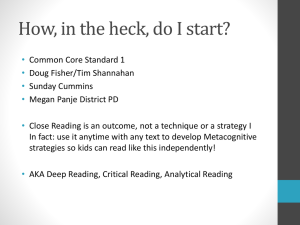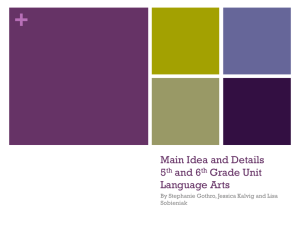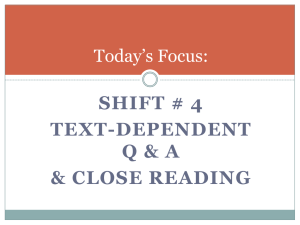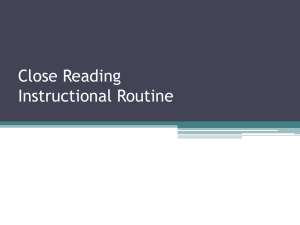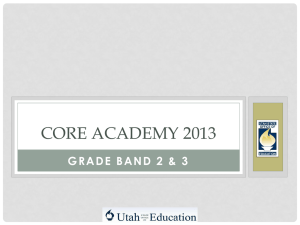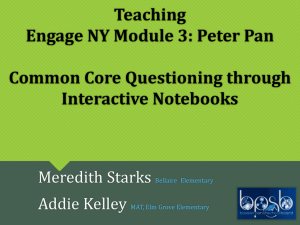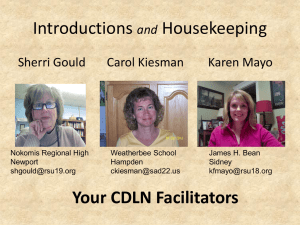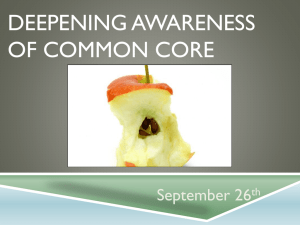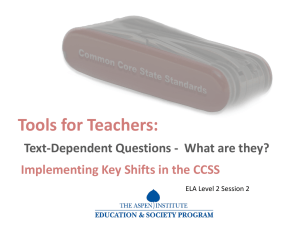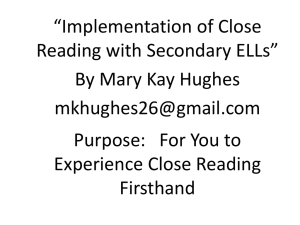Close Reading and Text-Dependent Questions PART II
advertisement
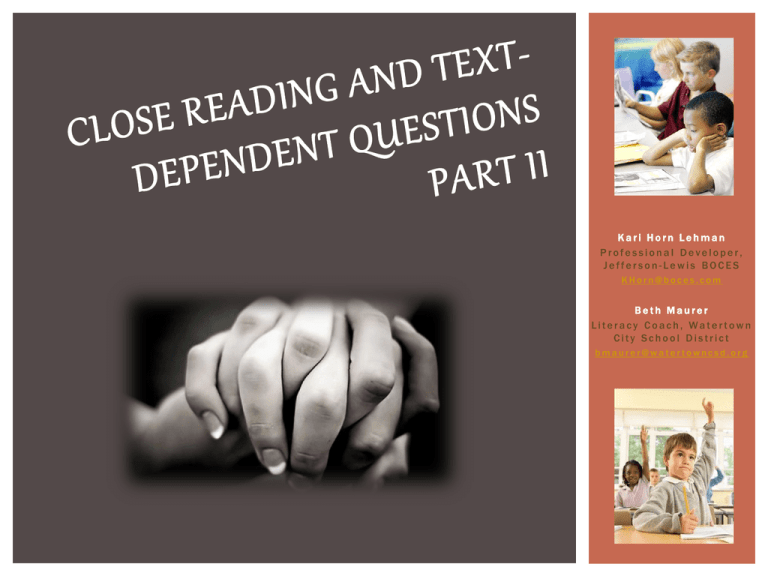
Kari Horn Lehman Professional Developer, Jefferson-Lewis BOCES KHorn@boces.com Beth Maurer Literacy Coach, Watertown City School District bmaurer@watertowncsd.org NORMS OF COLLABORATION Take some “I Time” to read through The Seven Norms of Collaboration. Tag the text according to the symbols below: The Norm in which you are really good The Norm on which you will focus today BELLRINGER Using the Seven Norms of Collaboration, Turn and Talk about your response to the Bellringer Prompt. 2 minutes! OBJECTIVES/LEARNING TARGETS I can analyze the implementation of a Close Reading lesson and use the analysis to clarify my own understanding. I can develop a Close Reading lesson plan. I can apply my lesson plan in my classroom this quarter. Silent, fist-to-five rating REFLECTION: PLANNING A CLOSE READING After Close Reading and Text-Dependent Questions Part I, we wanted to model Close Reading in the classroom Beth and Kari co-planned and practiced a Close Reading Lesson Our Text – 3 rd Grade, “Move to the Beat” ANALYZING THE TEXT USING THE INSTRUCTIONAL PRACTICE GUIDE KEY ELEMENTS OF OUR CLOSE READ* 1. Complex Texts (Read Aloud Anthology) 2. Outcomes/Objectives 3. Explicit Direct Instruction (for teaching any new concept) 4. Multiple Reads 5. Asking and Answering Questions about the Text (Text-Dependent Questions) 6. Thinking, Talking, and Writing about the Text *These elements may change depending on your students’ experience with Close Reading and the purpose of each of your lessons OUR LESSON PLAN 1. Take some “I Time” to read through our lesson plan. 2. Visualize what this lesson might look like in the classroom. IDENTIFY THE KEY ELEMENTS Use the Norms of Collaboration to mark up the text (lesson plan) with a partner Look for and number the Six Key Elements of Our Close Read: 1. 2. 3. 4. 5. Complex Texts (Common Core, Text-complexity level aligned) Outcomes/Objectives Explicit Direct Instruction (for teaching any new concept) Multiple Reads Asking and Answering Questions about the Text (Text Dependent Questions) 6. Thinking, Talking, and Writing about the Text LARGE GROUP DEBRIEF From Beth CLOSE READING LESSON, PART I This video is available on my website: Videos/Close Reads TURN AND TALK Using the Seven Norms of Collaboration, Turn and Talk about what you saw. 60 seconds! ALIGNING OBJECTIVES WITH LEARNING STANDARDS Objectives/Learning Targets: I can use annotation text codes while reading I can use the language framework while answering text dependent questions. CLOSE READING LESSON, PART II This video is available on my website: Videos/Close Reads FILLING IN THE GAPS (IN THE VIDEO) According to the Close Reading Lesson Plan, what happened next? From Beth TEXT-DEPENDENT QUESTIONS IN THIS LESSON Review the lesson to identify the Text -Dependent Questions that students will be asked 1. Who is the first character introduced in the first three paragraphs of this text? 2. According to the text, what does Bennisan use to teach schoolchildren from the United States about the music in his country? TOOLS FOR CREATING TEXT-DEPENDENT QUESTIONS 1. 2. 3. 4. Key Types*: Right There – literal, ask for information using the question stem itself to locate the answer at times Think and Search – also literal, but require the reader to compile the answer across several sentences or paragraphs Author and You – require students to use inferential skills to pair information from the text with their background knowledge On Your Own – invite students to formulate opinions based on their experiences as well as what they have learned from the text *Source: Fisher, Douglas and Nancy Frey. Engaging the Adolescent Reader: Text Complexity and Close Readings . January 2012 • • Who is the first character introduced at the beginning of this text? (Right There) According to the text, what does Bennisan use to teach schoolchildren from the United States about the music in his country? (Think and Search) THE FOCUS OF OUR TEXT-DEPENDENT QUESTIONS • • Who is the first character introduced at the beginning of this text? (Right There) According to the text, what does Bennisan use to teach schoolchildren from the United States about the music in his country? (Think and Search) CATEGORIES OF TEXT-DEPENDENT QUESTIONS FOR CLOSE READING Category of Question Question Starter Questions about what the text says, both explicitly and implicitly Who? What? Where? When? Why? Use specific details from the text to support your answer. Why do you think that...? What does [BLANK] mean? What can you infer about...? Questions about the author’s craft Why did the author choose...? How would this text be different if...? What does the author want you to think about...? In your own words, what is...? Questions requiring evaluation and analysis How is [BLANK] like/different from [BLANK]? What patterns can you find in...? What evidence does this author use to support his argument that...? LESSON CLOSING This video is available on my website: Videos/Close Reads Learning Together PLANNING YOUR OWN CLOSE READING LESSONS I do, you watch I do, you help You do, I help * You do, I watch PRACTICING! In your grade level groups, take time to practice the parts of your lesson that feel the most uncomfortable to you. NEXT STEPS * To have Beth model a lesson in your classroom or to invite Kari or Beth in to see your Close Reading lesson in action, do not hesitate to get in touch! Bmaurer@watertowncsd.org Khorn@boces.com
